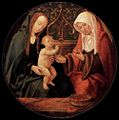Virgin and Child with Saint Anne

The Virgin and Child with Saint Anne This depiction has been popular in Germany and neighboring countries since the 14th century.
Names
Names for this particular subject in other languages include:
- Dutch: Anna te Drieën[6]
- French: Anne Trinitaire[7]
- German: Anna Selbdritt[8]
- Italian: Anna Metterza[1][7]
- Slovene: Ana Samotretja[9]

Background
In the 13th century, Jacobus de Voragine incorporated apocryphal accounts from the Protoevangelium of James regarding the parents of the Blessed Virgin Mary in his Golden Legend. The cult of St. Anne spread rapidly and she became one of the most popular saints of the Latin Church. Saint Anne was recognized as the patroness of grandparents, women in labor, and of miners, Christ being compared to gold, and Mary to silver.[10] Inscriptions on some medieval church bells indicate that Saint Anne was invoked for protection against thunderstorms.[11]
Mother and daughter
The subject of Saint Anne and the Virgin and Child was a popular subject in both painting and sculpture. This was due in part to its universality "—the love and tension between generations and also between humanity and the divine."[12] The Anna Selbdritt style, popular in northern Germany in the 1500s, demonstrates the medieval focus on the humanity of Jesus.[13] St. Anne's motherhood of Mary was viewed as mirroring Mary motherhood of Jesus.[14] In 1497, the German Benedictine abbot Johannes Trithemius, in his De purissima et immaculate conception virginis Marie et de festivitate sancta Annematris eius linked the Immaculate Conception of Mary to the devotion to her mother. While the matter of the Immaculate Conception remained a subject of debate between philosophers and theologians, the depiction of Joachim and Anne Meeting at the Golden Gate was sometimes interpreted as a symbolic representation of the conception of Mary. Saint Anne was revered as the avia Christi ("grandmother of Christ"), matriarch of the Holy Kinship and exemplary mother.[14]
Iconography

Fourteenth-century images of Saint Anne with the Virgin and Child were often modeled on the earlier seat of Wisdom motif.[15] Mary was often shown as a much smaller figure than her mother.[16] As devotion to St. Anne developed 14th century, sometimes a statue of the Madonna and Child was modified to include the additional figure of St. Anne.[14] Anne's traditional colors are green and red, although often she is shown wearing the more sober colors of an older woman.[17]
Depictions
Italian Renaissance painter
Around 1606 Caravaggio undertook a commission from the Confraternity of Sant' Anna dei Palafrenieri. He depicted the Virgin and Child treading on the head of the serpent, observed by St. Anne, who was the patron saint of the Palafrenieri.[20]
Gallery
-
Virgin and Child with St Anne, Leonardo da Vinci, c.1503
-
Anna Selbdritt, Egenburg
-
Anna selbdritt in Wehr around 1450
-
Anna Selbdritt, Lower Austria 1480
-
Anna-te-Drieën, Netherlands, c.1495
-
Santa Ana, el Niño Jesús y la Virgen (Benson), c.1495
-
Virgin and Child with St. Anne, Cornelis Engebrechtsz, c.1500
-
St Anne with Christ Child, the Virgin, and St John the Baptist, Baldung c.1511
Byzantine iconography
See also
- Coat of arms of Annaberg-Buchholz in the Saxony's Erzgebirge mountain range
- The Virgin and Child with St. Anne (Leonardo), c. 1503
- Virgin and Child with St. Anne (Masaccio), c. 1424
- Studies of an Infant
References
- ^ a b Tinagli, Paola. 1997. Women in Italian Renaissance Art: Gender, Representation and Identity. Manchester: Manchester University Press, p. 159.
- ^ Kahsnitz, Rainer. 2005. Carved Splendor: Late Gothic Altarpieces in Southern Germany, Austria and South Tyrol. Los Angeles: Getty Publications, p. 442.
- ^ Rowlands, Eliot Wooldridge. 2003. Masaccio: Saint Andrew and the Pisa Altarpiece. Los Angeles: Getty Publications, p. 22.
- ^ Feigenbaum, Gail, & Sybille Ebert-Schifferer, eds. 2011. Sacred Possessions: Collecting Italian Religious Art, 1500–1900. Los Angeles: Getty Publications, p. 40.
- ^ Sources of Christian Iconography incl. Protevangelium of James. the Golden Legend (131) and the Gospel of Pseudo-Matthew
- ^ Dresen-Coenders, Lène et al. 1987. Saints and She-Devils: Images of Women in the 15th and 16th Centuries. London: Rubicon Press, p. 87.
- ^ a b Murray, Peter et al. 2013. The Oxford Dictionary of Christian Art and Architecture. Oxford: Oxford University Press, p. 21.
- ^ Crăciun, Maria, & Elaine Fulton. 2011. Communities of Devotion: Religious Orders and Society in East Central Europe, 1450–1800. Farnham, UK: Ashgate, p. 50.
- ^ Jaki, Barbara. 2004. National Gallery of Slovenia: Guide to the Permanent Collection: Painting and Sculpture in Slovenia from 13th to the 20th Century. Ljubljana: National Gallery of Slovenia, p. 9.
- ^ Holweck, Frederick. "St. Anne." The Catholic Encyclopedia Vol. 1. New York: Robert Appleton Company, 1907. 29 August 2017
- ISBN 9780271024660
- ^ "It's a Family Affair", The Economist
- ^ "Anna Selbdritt Statue", Diocese of Lexington
- ^ ISBN 9781134997879
- ^ Nixon, p.134.
- ^ Nixon, p.114.
- ^ Nixon, p.148.
- ^ "Virgin and Child with Saint Anne", The Met
- ^ Virgin and Child with Saint Anne, Saint Gereon, and a Donor, Art Institute Chicago
- ^ "Madonna and Child with St. Anne", Caravaggio.org.
- ^ 11th-century mosaic Daphni monastery Greece depicting annunciation to Anna and Joachim)
- ^ Patristic prefigurement - notes on ancient watercourses in the Holy Land








